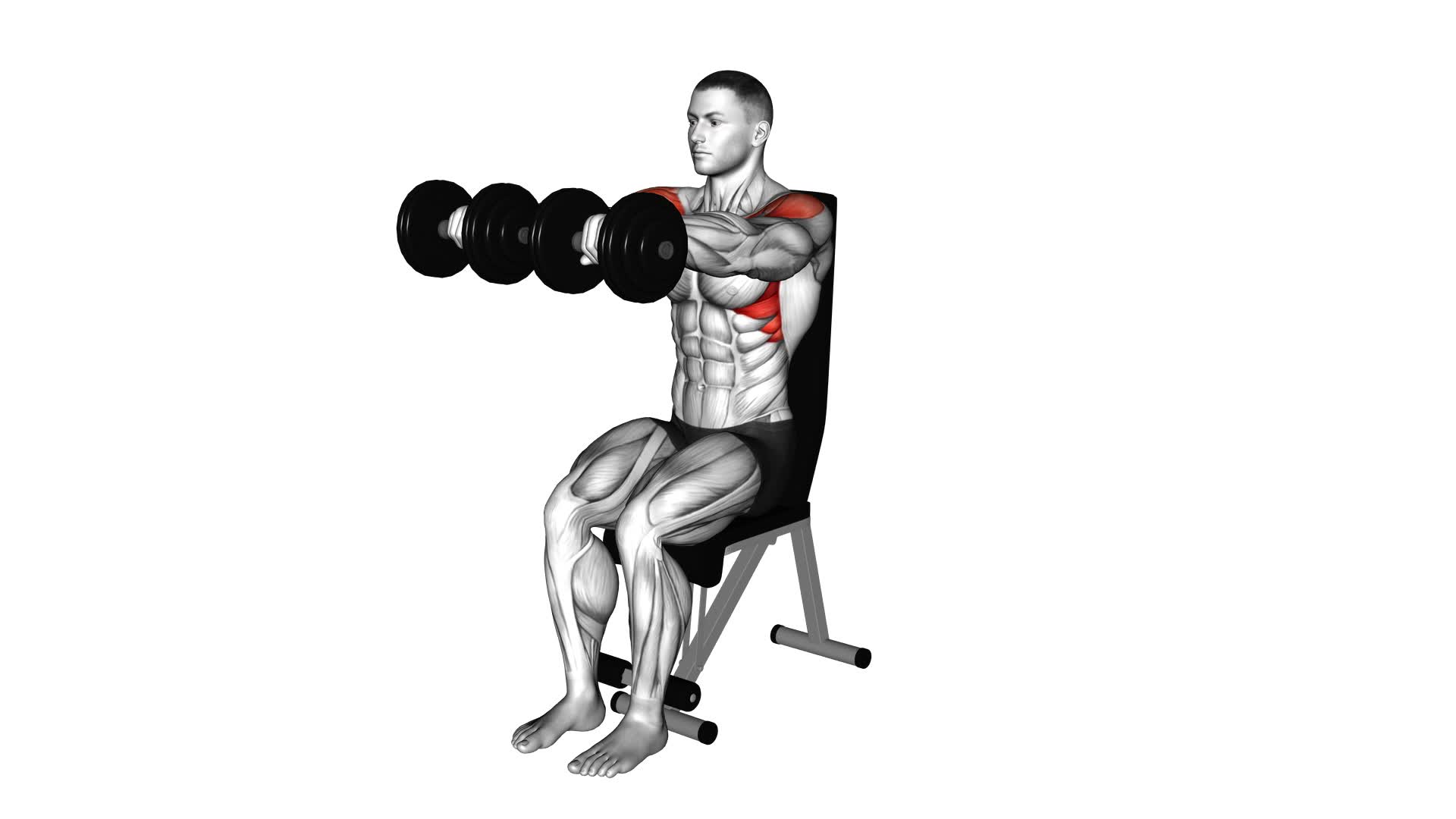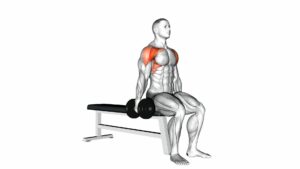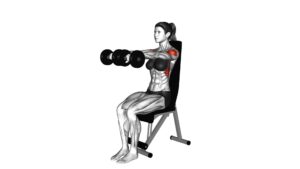Dumbbell Seated Front Raise – Video Exercise Guide & Tips

Are you looking for an effective exercise to target your shoulder muscles? Look no further than the dumbbell seated front raise!
Watch This Exercise Video
In this video exercise guide, we'll show you the proper form and technique to get the most out of this exercise. We'll also cover common mistakes to avoid, variations and modifications, and tips for maximizing your results.
Get ready to strengthen and sculpt your shoulders with this challenging yet rewarding exercise. Let's dive in!
Key Takeaways
- Dumbbell Seated Front Raise helps increase shoulder strength and stability.
- It effectively targets the anterior deltoids and engages the front shoulder muscles.
- Engaging the muscles in the upper back for stabilization is important during this exercise.
- Dumbbell Seated Front Raise improves overall upper body strength, posture, and aesthetics.
Benefits of the Dumbbell Seated Front Raise
You will experience increased shoulder strength and stability from performing the Dumbbell Seated Front Raise. This exercise primarily targets the anterior deltoids, which are the muscles at the front of your shoulders. By using dumbbells, you're able to isolate and engage these muscles effectively.
To perform the Dumbbell Seated Front Raise, you'll need a pair of dumbbells. Start by sitting on a bench with your feet flat on the floor and your back straight. Hold a dumbbell in each hand with your palms facing down and your arms extended straight in front of you. Keep a slight bend in your elbows throughout the movement. Slowly lift the dumbbells upwards until they're at shoulder height, then lower them back down to the starting position.
This exercise not only targets the anterior deltoids, but also engages the muscles in your upper back, including the trapezius and rhomboids, as they work to stabilize your shoulders during the movement. By regularly incorporating the Dumbbell Seated Front Raise into your workout routine, you can improve your shoulder strength and stability, which can enhance your performance in other exercises and daily activities that require upper body strength.
Proper Form and Technique
To ensure proper form and technique for the Dumbbell Seated Front Raise, it's important to maintain a neutral spine and engage your core muscles throughout the exercise. This exercise is great for shoulder strengthening and muscle activation.
Start by sitting on a bench or chair with your feet flat on the ground and your back straight. Hold a dumbbell in each hand, with your palms facing down and your arms extended in front of you. As you lift the dumbbells, exhale and raise them to shoulder height, keeping your arms straight and your elbows slightly bent. Avoid using momentum or swinging your body to lift the weights. Pause briefly at the top of the movement, then inhale as you slowly lower the dumbbells back to the starting position.
Remember to focus on maintaining a neutral spine and engage your core muscles throughout the exercise. This will help to prevent any excessive strain on your lower back. By following these proper form and technique guidelines, you can maximize the effectiveness of the Dumbbell Seated Front Raise and minimize the risk of injury.
Now let's move on to the next section and discuss common mistakes to avoid.
Common Mistakes to Avoid
Avoid these common mistakes when performing the Dumbbell Seated Front Raise to ensure proper form and maximize your shoulder strengthening and muscle activation.
- Using too much weight: It's important to start with a weight that allows you to maintain proper form throughout the exercise. Using excessive weight can lead to compensation and improper technique, reducing the effectiveness of the exercise and increasing the risk of injury.
- Lifting with momentum: Avoid using momentum to lift the dumbbells. This can take the focus away from your shoulder muscles and shift it to other areas of your body. Instead, focus on controlled movements, lifting and lowering the dumbbells in a slow and controlled manner.
- Rounding your back: Keep your back straight and avoid rounding your shoulders forward during the exercise. Rounding your back not only compromises your form but also puts unnecessary strain on your spine. Maintain a neutral spine position throughout the movement.
- Neglecting full range of motion: Aim to raise the dumbbells to shoulder level or slightly above, ensuring a full range of motion. Avoid stopping short of the desired range as this limits the activation of your shoulder muscles. Maintain control as you lower the dumbbells back to the starting position.
Variations and Modifications
To modify the Dumbbell Seated Front Raise, you can incorporate different grips for added challenge and muscle engagement. By using different grip options, you can target specific muscles and vary the intensity of the exercise.
One option is to use an overhand grip, where your palms face down and your thumbs wrap around the dumbbells. This grip primarily targets the front deltoids.
Another option is to use an underhand grip, where your palms face up and your thumbs wrap under the dumbbells. This grip emphasizes the upper chest and front deltoids.
By alternating between these two grips, you can effectively work different muscles in your shoulders and chest.
In addition to varying your grip, you can also incorporate resistance bands to increase the difficulty of the Dumbbell Seated Front Raise. Attach the resistance band to a stable object, such as a pole or a door handle, and hold onto the ends of the band while performing the exercise. The resistance from the band adds an extra challenge to the movement, forcing your muscles to work harder.
By incorporating different grip options and resistance bands, you can add variety and intensity to your Dumbbell Seated Front Raise routine. These modifications allow you to target specific muscle groups and continue challenging yourself as you progress.
Now, let's move on to the next section to learn some tips for maximizing your results.
Tips for Maximizing Results
Maximize your results by incorporating proper form and maintaining consistent effort throughout your Dumbbell Seated Front Raise routine. Here are some tips for beginners and alternative exercises to help you achieve the best possible outcome:
- Start with lighter weights: As a beginner, it's important to focus on building proper form and technique before increasing the weight. Begin with lighter dumbbells and gradually increase the weight as you become more comfortable and confident.
- Engage your core: To maximize the effectiveness of the exercise, remember to engage your core muscles throughout the movement. This will help stabilize your body and prevent unnecessary strain on your lower back.
- Control the movement: Avoid using momentum to lift the dumbbells. Instead, focus on a slow and controlled motion, lifting the weights up to shoulder level and lowering them back down in a controlled manner. This will ensure that you're targeting the correct muscles and maximizing your results.
- Explore alternative exercises: If you find the Dumbbell Seated Front Raise too challenging or uncomfortable, there are alternative exercises that target the same muscle groups. Some alternatives include the Barbell Front Raise, Cable Front Raise, or Resistance Band Front Raise. Experiment with different exercises to find the one that works best for you.
Frequently Asked Questions
How Heavy Should the Dumbbells Be for the Seated Front Raise Exercise?
When doing the seated front raise exercise, it's important to choose the right dumbbell weight for you. The proper form is crucial to avoid injury and maximize results.
The weight you choose will depend on your fitness level and strength. Start with a lighter weight and gradually increase as you get stronger.
Remember to maintain proper form throughout the exercise, keeping your back straight and engaging your core. This will ensure you get the most out of the exercise.
Can the Seated Front Raise Exercise Be Performed Without a Bench or Chair?
Yes, the seated front raise exercise can be performed without a bench or chair. There are alternative exercises you can try, such as the standing front raise or the cable front raise.
However, performing the seated front raise has its own unique benefits. It helps isolate and strengthen the front deltoids, improves shoulder stability, and can be easier on the lower back compared to standing exercises.
Is It Necessary to Warm up Before Performing the Dumbbell Seated Front Raise?
Before performing the dumbbell seated front raise, it's important for you to warm up. Warming up helps to increase blood flow, improve flexibility, and reduce the risk of injury during the exercise. It prepares your muscles and joints for the upcoming workout.
If you're looking for alternatives to the seated front raise exercise, you can try standing front raises or cable front raises. These exercises also target the front deltoids effectively.
Can the Seated Front Raise Exercise Be Modified for Individuals With Shoulder Injuries?
If you have a shoulder injury, it's important to modify the seated front raise exercise to avoid further damage.
There are several modifications you can try to relieve the strain on your shoulders. For example, you can use lighter weights or resistance bands to reduce the load.
Additionally, you can perform the exercise with your arms bent at a 90-degree angle or limit the range of motion.
These modifications will help protect your injured shoulder while still benefiting from the exercise.
How Often Should the Dumbbell Seated Front Raise Be Incorporated Into a Workout Routine for Optimal Results?
To achieve optimal results, it's important to incorporate the dumbbell seated front raise into your workout routine with the right frequency.
This exercise targets your shoulders and can help build strength and definition. By performing it regularly, you'll see improvements in your upper body strength and posture.
However, it's crucial to listen to your body and not overdo it. Start with 2-3 times a week and gradually increase the frequency as your strength and endurance improve.
Conclusion
In conclusion, the dumbbell seated front raise is a highly effective exercise for targeting the front deltoids and improving shoulder strength and stability.
By following the proper form and technique, avoiding common mistakes, and incorporating variations and modifications, you can maximize your results.
Remember to start with lighter weights and gradually increase the intensity as you progress.
With dedication and consistency, this exercise can help you achieve your fitness goals.

Author
Years ago, the spark of my life’s passion ignited in my mind the moment I stepped into the local gym for the first time. The inaugural bead of perspiration, the initial endeavor, the very first surge of endorphins, and a sense of pride that washed over me post-workout marked the beginning of my deep-seated interest in strength sports, fitness, and sports nutrition. This very curiosity blossomed rapidly into a profound fascination, propelling me to earn a Master’s degree in Physical Education from the Academy of Physical Education in Krakow, followed by a Sports Manager diploma from the Jagiellonian University. My journey of growth led me to gain more specialized qualifications, such as being a certified personal trainer with a focus on sports dietetics, a lifeguard, and an instructor for wellness and corrective gymnastics. Theoretical knowledge paired seamlessly with practical experience, reinforcing my belief that the transformation of individuals under my guidance was also a reflection of my personal growth. This belief holds true even today. Each day, I strive to push the boundaries and explore new realms. These realms gently elevate me to greater heights. The unique combination of passion for my field and the continuous quest for growth fuels my drive to break new ground.







